
Rhododendrons are quite easy to grow as long as you have well drained but moist acidic soil.
They wont tolerate deep and dry shade and poor drainage/heavy clay soil. And they wont grow in areas with chalky/limey soil unless in raised beds.
Rhododendrons which are not happy tend to show this by their leaves turning yellow.
There are several reasons that this may happen. So why has my rhododendron got yellow leaves?
Reasons include:
The causes of failure are listed in order: commonest cause of failure first.
1. Drainage:
More rhododendrons are killed by waterlogging and poor drainage than any other cause. If the soil is boggy, heavy clay or compacted, rhododendrons will not grow for long and will likely die. Dark brown dead roots= Phytophthora caused by poor drainage. (NOT the same as Sudden Oak Death.) See below for detailed section on this problem.
2. Incorrect Depth of Planting:
Rhododendrons are surface rooting and MUST NOT be planted deep. The top of the rootball should remain at or just below the soil surface. If you bury the roots under soil the plant will die. Beware of putting deep mulch on top of rootballs. Roots need to breathe.
3. Variety not hardy enough?
Check hardiness rating and for bark split. 2009-10 Winter was very severe all over Europe. Worst affected were plants in containers as the roots froze solid. Most rhododendrons and azaleas came through well and most of those damaged have grown from below, at Glendoick. Northern Europe had very severe conditions in Spring 2013 but what I observed many plants, especially dwarf lepidotes are producing young growth and will recover. Bark split is typically caused by late frosts in Spring or early Autumn frosts when sap is running in the stem of the plant. It can heal up but a bad case of barksplit can kill young plants. It can often take 6-9 months before you notice a sudden collapse. Check the stem at the base of the plant.
4. Vine weevils?
Check the stem just above ground. If bark has been eaten, usually girdling stem: vine weevil are probably the cause. The bark is eaten by white grubs in the soil usually in late summer or over winter. Adults notch the leaves in spring. Vine weevil are more of a problem in pots and indoors than in the garden. Most commercial plants are protected by compost insecticide. Beware amateur gifts of Primulas, strawberries and other weevil favourites in case there are grubs in the compost.
5. Honey fungus
(Armillaria mellea) Roots are full of black bootlaces with white core).

This fungus can attack and kill rhododendrons in the woodland garden or areas where tree stumps are prevalent. Sometimes sending up conspicuous fruiting bodies, the main part of the fungus lives underground, sending out vigorous rhizomorphs (commonly known as bootlaces), which colonise both dead and living tree and plant roots. Gardens with lots of old tree-stumps in the ground are at most risk Of course, one can glibly recommend that all tree roots be removed but this is impossible with the enormous root systems mature broad leaf trees such as elm, beech or sycamore. Digging out a dead plant killed by honey fungus will usually reveal the tell-tale black bootlaces which have run through the root ball and into the stem, virtually strangling it in severe cases. Symptoms vary from yellowing of leaves, poor leaf retention, poor growth length, partial dieback of branches on the plant, or sudden total collapse. Often a last gasp attempt to flower heavily will be made. There is little doubt that stressed plants (by water logging, drought etc) are more susceptible to the fungus. Certain species such as R. lacteum, most of subsection Taliensia and many in subsection Neriiflora are particularly at risk, while many hybrids seem to be able to withstand having the fungus in their roots, though it can reduce their vigour.
There is very little else you can do about Armillaria, apart from using artificial barriers to keep it from spreading. The fungus usually remains close to the surface, seldom deeper than 30-45cm in lighter soils, though it is said to go deeper in clay soils, so heavy duty plastic and other materials can be used to make impermeable barriers rather like underground walls. Alternatively, plants can have an underground wall made in a circle around the root ball. Raised beds with a solid lining are another solution, but ensure there is adequate drainage: try to construct on a slope if possible. We have tried using permeable membranes but the fungus appears to be able to penetrate these.
Caterpillars
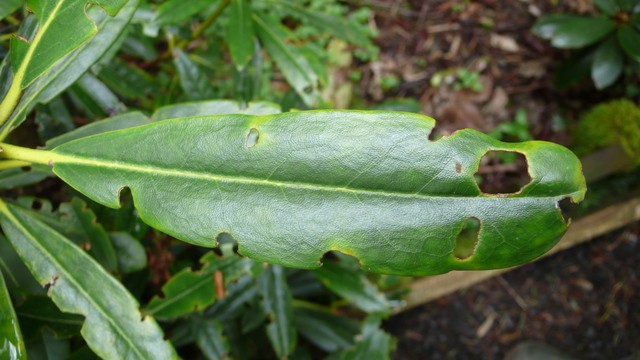 Holes in the leaves (internal) and irregular chunks of leaf removed (as opposed to notches around the edge) are the symptoms of caterpillars.
Holes in the leaves (internal) and irregular chunks of leaf removed (as opposed to notches around the edge) are the symptoms of caterpillars.
Vine weevil foliage damage
Vine weevils notch the outer edges of the leaf only.
If you see holes in the leaf, this is caterpillar damage.
The danger from vine weevils is that the larvae eat the roots.
Weevils cant fly so they tend to drop from overhanging conifers or other shrubs. Cut back the shade and shelter and you may escape damage. Vine weevils love to live in Leylandii hedges.
See section on vine weevil grubs.
Rhododendrons are toxic to many animals which usually know not to eat them, but there are cases of sheep and cattle poisoning from time to time.
Horses and cattle are more likely to cause breakage than to graze your plants; this and the soil compaction that they can cause means that is advisable to keep farm animals fenced from your rhododendrons.
Birds can cause considerable damage, both in dust bathing and in looking for food, especially around small, newly planted stock.
Indoors and in frames, mice and voles can be troublesome, especially in cold and snowy winters.
Both these animals can cause great destruction in the rhododendron garden. We find Scottish rabbits can eat most evergreen azaleas and species deciduous azaleas such as R. albrechtii.
When grazing is lush and there is plenty to eat, rhododendrons are often left well alone. The problems usually occur when there is snow on the ground, especially when the ground is frozen solid.
Often rhododendrons are one of the few evergreen plants which the deer and rabbits can easily reach and so considerable damage such as the loss of leaf tips, branch tips or more seriously, the stripping of the bark, may occur. Ideally fencing is the perfect option but this is expensive, especially where deer are concerned. To fence effectively against rabbits, use netting at least 1 metre wide and bury 10-15cms in the ground to prevent them from digging underneath.
In really severe infestations, it may be necessary to poison rabbit warrens using sodium cyanide or similar gasses. Such chemicals are potentially very dangerous and countries have strict regulations as to who is allowed to use them.
An effective deer fence needs to be 2m high for Roe deer (the most common deer species in the U.K.) but may need to be higher where larger species of deer occur. Several commercial animal repellents have been developed over the years. The most common is aluminium ammonium sulphate (sold under the name 'scoot', 'stay off' etc). Grazers, a calcium compound is effective as a foliar spray to keep rabbits from grazing plants.
In a last resort, someone will need get a gun out, as the populations of deer and rabbits in some areas are far larger than the environment can sustain.
Fungal Disease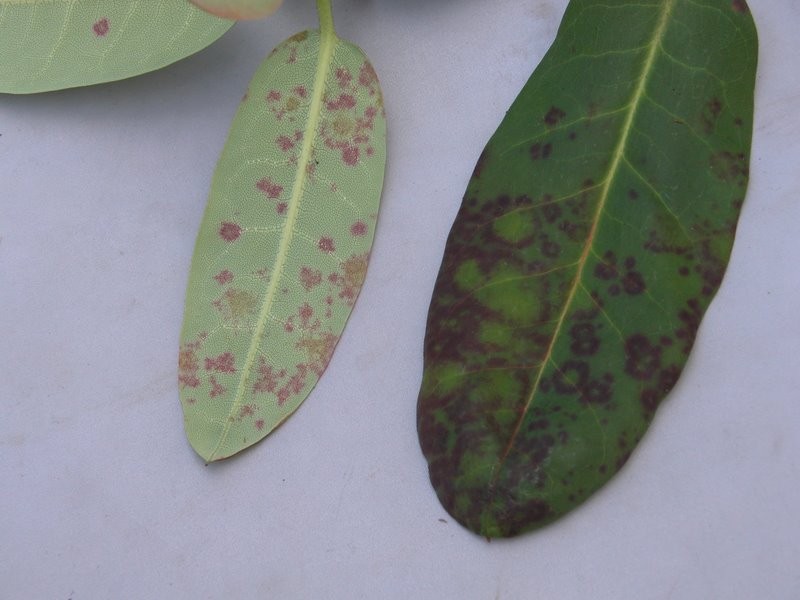 Powdery Mildew: symptoms are pale spots on upper leaf surface, with
Powdery Mildew: symptoms are pale spots on upper leaf surface, with
corresponding brown/grey patches underneath:
Control with fungicide from late May onwards.
Any rose fungicide will do: myclobutanil (systhane), fungus fighter, roseclear etc.
If the infections are mild, just live with it. Some hybrids such as 'Elizabeth' are very susceptible and are better destroyed
Rust:
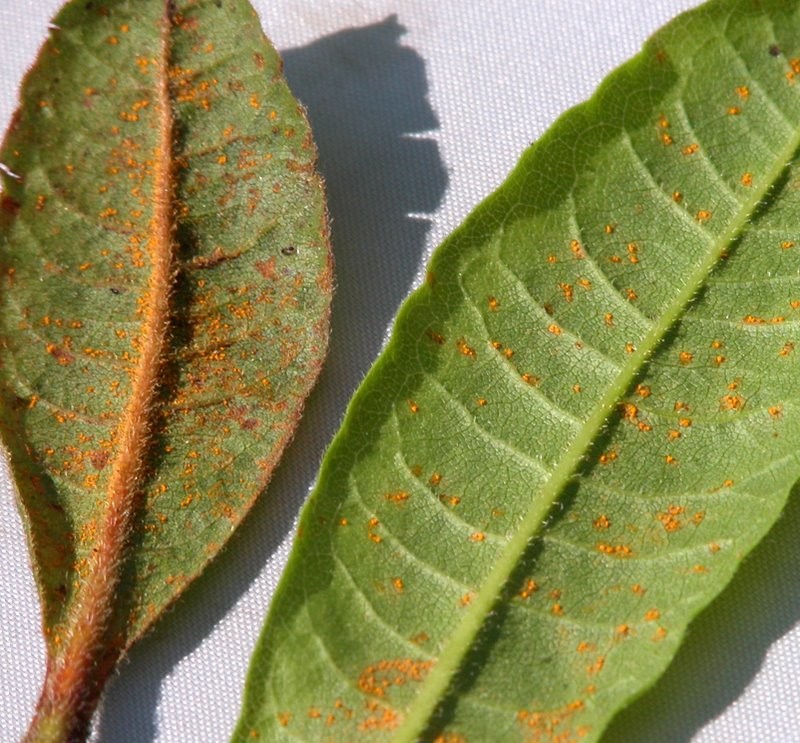
Black spots on upper surface, lower surface with orange patches: Control
with rose fungicides. Roseclear, etc.
A few rhododendron hybrids such as Anna Baldsiefen, Arctic Tern and Azaleodendrons are very susceptible.
Powdery mildew on deciduous azaleas.
This is a different mildew species.
It tends to attack those with R. luteum and R. occidentale in their breeding: so paler colours.
It coats the leaf upper surface with white in late summer.
Unsighly but not usually harmful though if the plants defoliate early for a few years they can be weakened.
Black spots with no patches on leaf undersurface
Some varieties eg ‘Mrs GW Leak' get this. Nothing to worry about, not a disease.
Root rot/wilt
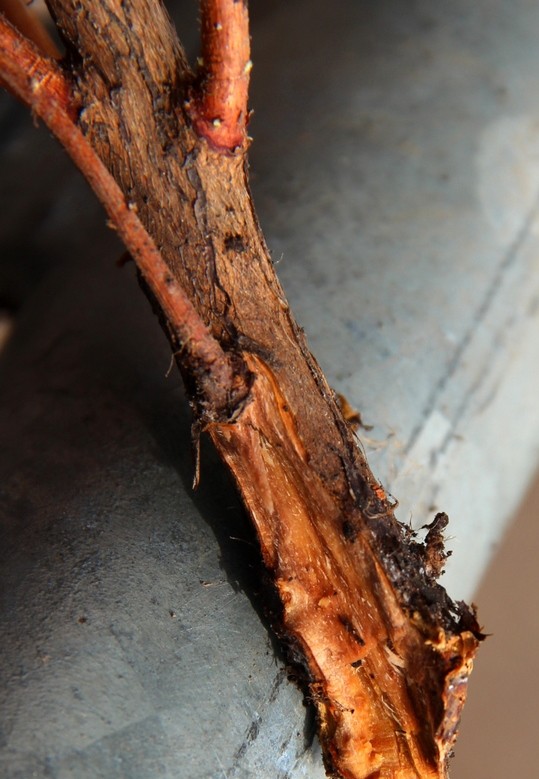 Phytophthora cinnamoni is a root disease which is usually fatal and often kills a plant extremely quickly. The symptoms are (usually) a sudden collapse during the growing season, usually of the whole plant or several plants in one area of the garden. Check the roots and cut into the stem of the plant. The disease is characterised by the roots turning a deep brown colour (rather than white as healthy growing roots should be). If you scrape away the bark at ground level, you will find the cambium layer below the bark has been stained a dark reddish-brown colour. The disease is caused by inadequate drainage and warm or hot soil temperatures. The combination of these is very often fatal to rhododendrons. It is most common in areas with hot summers but can occur anywhere if poor drainage is allowed to occur. Phythopthora cinnamomii is most active at a soil temperature of 29-22C (68-72F). Plants in containers are particularly susceptible, especially if watered overhead with sprinklers. The photo below shows the red-brown staining, the proof of infection in the stem of the dead plant.
Phytophthora cinnamoni is a root disease which is usually fatal and often kills a plant extremely quickly. The symptoms are (usually) a sudden collapse during the growing season, usually of the whole plant or several plants in one area of the garden. Check the roots and cut into the stem of the plant. The disease is characterised by the roots turning a deep brown colour (rather than white as healthy growing roots should be). If you scrape away the bark at ground level, you will find the cambium layer below the bark has been stained a dark reddish-brown colour. The disease is caused by inadequate drainage and warm or hot soil temperatures. The combination of these is very often fatal to rhododendrons. It is most common in areas with hot summers but can occur anywhere if poor drainage is allowed to occur. Phythopthora cinnamomii is most active at a soil temperature of 29-22C (68-72F). Plants in containers are particularly susceptible, especially if watered overhead with sprinklers. The photo below shows the red-brown staining, the proof of infection in the stem of the dead plant.
Rootrot-susceptible rhododendron varieties:
Root rot reduction/avoidance:
Drought and flooding makes plants more susceptible.
If you grow any of these species, make sure that drainage is near perfect. Mound plant or used raised beds if you have high rainfall.
1. Ensure that the planting area is well prepared with coarse organic and inorganic matter to ensure free drainage and maintain aeration in the soil. Freshly composted bark has been shown to have some root-rot resistant properties
2. Ensure that the soil where the rhododendrons are growing is not allowed to become compacted by people or animals walking over it.
3. In warmer climates, growing in shade and mulching will help to keep the soil temperature down.
4. Grafting In Germany, most varieties of rhododendron are grafted, which increases tolerance of poorly-drained soils.
5. Raised planting area In areas with heavy clay soils, the best practice is often to plant above soil level, either in raised beds or by mounding up the soil around the root of the plant.
Stem Diebacks
(Botryosphaeria (canker), Phytophthora cactorum, P. ramorum, P. kernoviae)
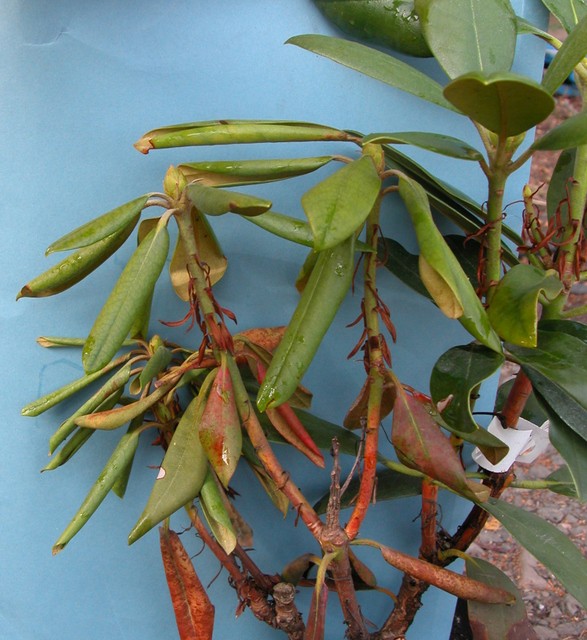 These can be serious diseases of rhododendrons particularly in regions with considerable summer heat and or humidity. They are characterised by the sudden wilting and death of a branch or part of a plant and tend to attack where plants have been physically damaged in some way. Check the inside of the wilted stem for diagnosis: it will normally have turned brown, usually with a dark reddish-brown core. The dead stem must be cut out well into green wood in the healthy part of the plant and the dead branch should be disposed of or burnt but not composted. Ensure secateurs are sterilised using bleach or alcohol to avoid spreading the disease. Good hygiene, adequate air circulation and moderate use of fertiliser all help prevent the diseases. Drought stress increases susceptibility to the disease. Botryosphaeria can begin as leaf spot and go on to cause stem dieback. There is no effective chemical control for this disease. For Phytophthora, fungicides such as mancozeb, metalaxyl and fosetyl-aluminium can be used but not by amateurs.
These can be serious diseases of rhododendrons particularly in regions with considerable summer heat and or humidity. They are characterised by the sudden wilting and death of a branch or part of a plant and tend to attack where plants have been physically damaged in some way. Check the inside of the wilted stem for diagnosis: it will normally have turned brown, usually with a dark reddish-brown core. The dead stem must be cut out well into green wood in the healthy part of the plant and the dead branch should be disposed of or burnt but not composted. Ensure secateurs are sterilised using bleach or alcohol to avoid spreading the disease. Good hygiene, adequate air circulation and moderate use of fertiliser all help prevent the diseases. Drought stress increases susceptibility to the disease. Botryosphaeria can begin as leaf spot and go on to cause stem dieback. There is no effective chemical control for this disease. For Phytophthora, fungicides such as mancozeb, metalaxyl and fosetyl-aluminium can be used but not by amateurs.
Phythopthora ramorum (Sudden Oak Death)
A disease which has caused much worry, recently. I suspect it has been around for many years and that scientists have only just recognised it as a separate species. The disease has been found on a wide variety of plants including Rhododendron, Camellia, Viburnum, Pieris, Kalmia, Taxus, and the symptoms are similar to those of Botryosphaeria die back. It can spread from Rhododendrons onto other plants such as larch trees which are usually killed by it. Rhododendron ponticum is by far the worst host for it. Indeed most outbreaks in gardens seem to be traced back to infection on R. ponticum. if you can get rid of this species, I'd recommend doing so. Thought to be spread by water-splashing, its effects on rhododendrons are often not very severe, causing limited stem die-back.
Symptoms
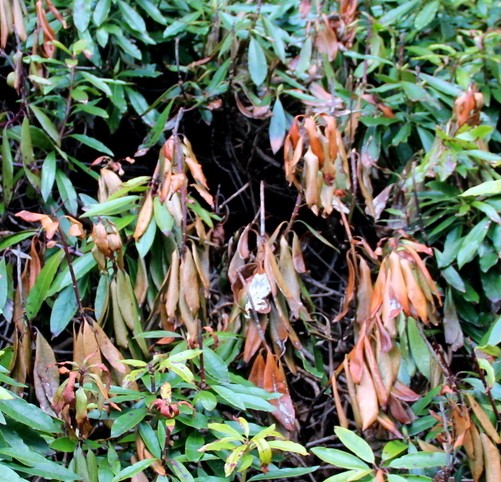 The symptoms are shown in the photo below. Look out for the dieback starting as staining up the petiole from the base of the leaf. If you see symptoms like this you should have your plants tested. Outbreaks of this disease are required to be notified to agricultural authorities and infected plants must be destroyed.
The symptoms are shown in the photo below. Look out for the dieback starting as staining up the petiole from the base of the leaf. If you see symptoms like this you should have your plants tested. Outbreaks of this disease are required to be notified to agricultural authorities and infected plants must be destroyed.
I suspect that over time this will just be perceived as just another fungal disease, particularly prevalent in mild and warm areas such as California and Cornwall, England and which we will just have to learn to live with.
Glendoick's nursery is regularly tested for the disease.
Petal Blight (Ovulinia)
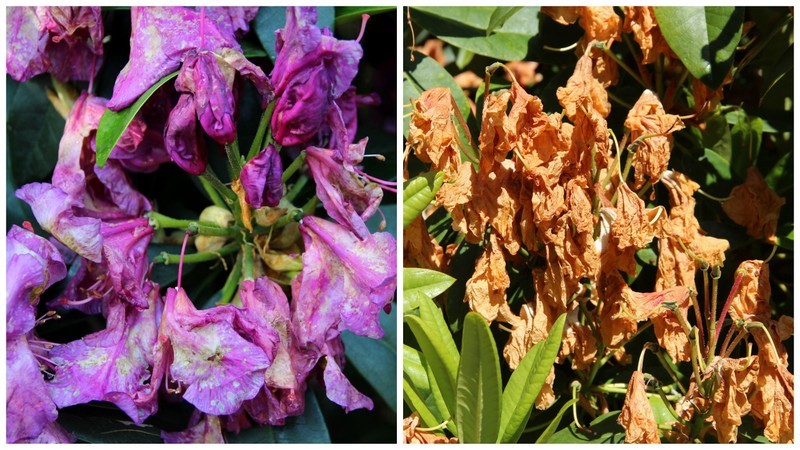
This fungal disease is one of the most upsetting diseases as it ruins the flowers you have waited so long to enjoy. Infected flowers first exhibit small spots which appear water-soaked. These rapidly enlarge turning the petals into a slimy grey mass with sinks limply onto the leaves below. It can even strike before the flowers open. It takes 2-3 days for the flowers to be completely ruined and a whole bush or group of plants can quickly be affected. The destroyed petals dry stick to the foliage and white patches which turn to black fruiting bodies are produced which will infect the following year's flowers. The disease usually occurs during moist weather at flowering time, especially if accompanied by warmth and poor air circulation. Watering overhead so that it wets the flowers is to be avoided if possible. If you have an infected plant brought in from another source, it is well worth removing all blooms immediately so that the spores cannot be spread. If you have a large amount of infection, it may be necessary to spray with a fungicide containing myclobutanil, from when buds start to show colour at weekly intervals until the flowers go over. Keeping the foliage and especially the flowers as dry as possible is the best way to avoid the disease.
Azalea Galls
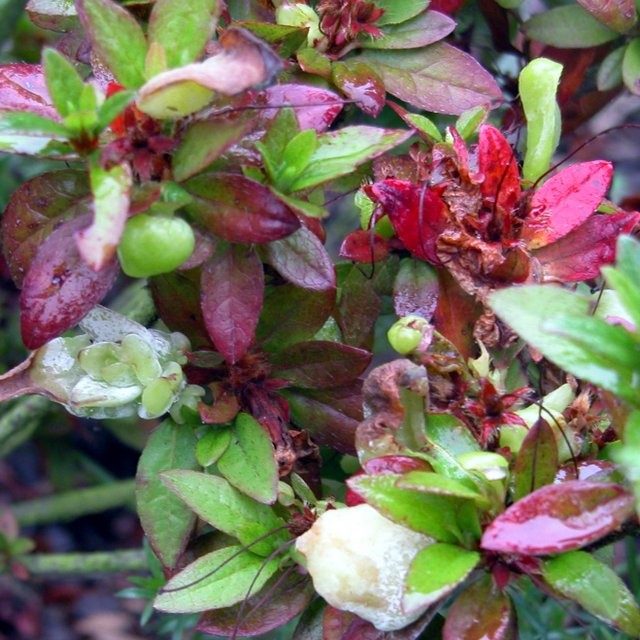 This unsightly fungal disease is characterised by green, pink or red swellings on the leaves and shoots. It is found on wild populations of some species and also found in gardens on some species and hybrids, and especially on evergreen/Japanese azaleas and R. ferrugineum and its hybrids. The diseased part should be picked off and destroyed: the problem usually occurs only once a season with the main flush of new growth. Many of the fungicides used to control mildew and rust also seem to have an effect in reducing this disease. Many authorities claim that galls are spread by an insect but I have never seen any firm evidence for this.
This unsightly fungal disease is characterised by green, pink or red swellings on the leaves and shoots. It is found on wild populations of some species and also found in gardens on some species and hybrids, and especially on evergreen/Japanese azaleas and R. ferrugineum and its hybrids. The diseased part should be picked off and destroyed: the problem usually occurs only once a season with the main flush of new growth. Many of the fungicides used to control mildew and rust also seem to have an effect in reducing this disease. Many authorities claim that galls are spread by an insect but I have never seen any firm evidence for this.
Scale Insect on rhododendrons and camellias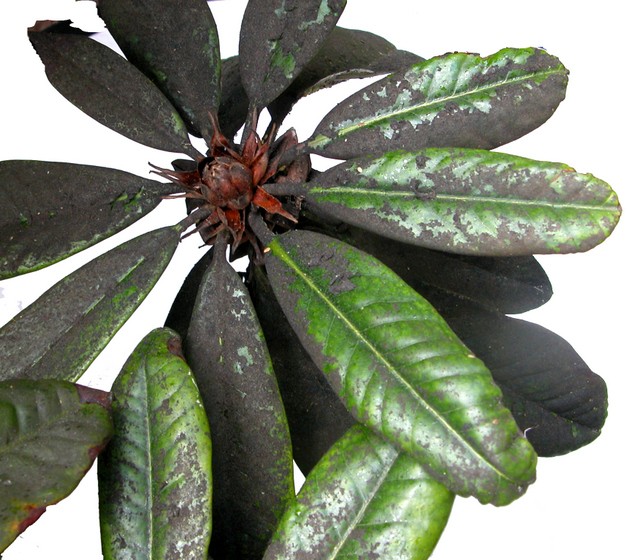
The most enquired about problem in the UK now and getting worse.
Few larger woodland gardens are free of it these days.
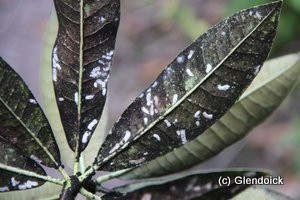 Symptoms: Look for sticky black secretions on the upper surface. The small scale insects 1mm wide are like translucent circles stuck on the lower leaf. When they hatch they leave a white fluffy cotton-like patch on the lower leaf surface
Symptoms: Look for sticky black secretions on the upper surface. The small scale insects 1mm wide are like translucent circles stuck on the lower leaf. When they hatch they leave a white fluffy cotton-like patch on the lower leaf surface
The only way to get rid of it is to prevent the adults hatching and laying on the young leaves in summer. Deltametherin (sold commercially as Decies) and for amateurs as 'Provanto' is effective. Mix with a wetting agent for best results to help the pesticie adhere to the leaf. Other synthetic pyrethroids include lambda-cyhalothrin (Westland Resolva Pest Killer) and cypermethrin (e.g. Py Bug Killer). Petroleum oil has also been recommended.
As the scale insects are on the underside of the leaf, it needs a particular approach,: You need a very high pressure sprayer which makes tiny droplets of spray and add a wetting agent. You might need to spray twice in the season. It is crucial for the lower leaf surface to be coated/covered. The time to spray is June-July/August to stop the young newly hatched crawler insects moving fronm the old growth to the new young growth. At this point they are most vulnerable to insecticide. Old scales may remain on the plant for some time after the death of the insect. To check if treatment has worked, slide your thumb across a group of scales. If scales are dead, they will be hollow and the coverings will flake off easily. Living scales will leave a colored, wet residue on your thumbnail.
Hard pruning a badly infected camellia or rhododendron can be the best way to get rid of it. For a large garden with a bad outbreak I recommend a mixture of cutting back and burning and spraying. Get a contractor in to spray if you dont have access to a high pressure, small droplet commercial sprayer.
As the insects are on the underside of the leaf, it needs a particular approach,: You need a very high pressure sprayer which makes tiny droplets of spray and add a wetting agent. These two things allow both the upper and lower leaf surface to be coated/covered. The time to spray is June-July/August to stop the insects moving fronm the old growth to the new young growth.
The chemical we use is deltamethrin.
RHS WEBSITE has the following options
The synthetic pyrethroid insecticides deltamethrin, lambda-cyhalothrin cypermethrin: contact sprays.
Systemic neonicotinoid insecticide acetamiprid
Organic Sprays: fatty acids plant oils and extracts, natural pyrethrum. These pesticides have very little persistence and so may need several applications during the scale's egg-hatching period.
Aphids on rhododendrons
Whitefly and greenfly can suddenly appear in large number on the underside of young leaves and on the stems,
particularly in dry weather, sucking out the sap and causing puckered or wrinkled leaves.
Vireya rhododendrons seem particularly prone to attack.
Spray with a contact insecticide or systemic insecticide:
Pyrethroids: Deltamethrin (e.g. Baby Bio Houseplant Bug Killer,
Provanto Ultimate Bug Killer,
Sprayday Greenfly Killer,
Provanto Ultimate Fruit & Vegetable Bug Killer),
lambda-cyhalothrin (e.g. Westland Resolva Bug Killer)
cypermethrin (e.g. Py Bug Killer).
Organics: Natural pyrethrum, Fatty acids, Plant oils.
If you dislike using chemicals, soap concentrates can be used.
It may take several doses to clear the infestation.
With both chemicals and soap sprays, it is important to target the insects on the leaf undersides.
This requires a fine spray to allow the water droplets to adhere.
There are also a number of biological controls which are most effective under glass.
These include Aphidoletes (midge) and Aphideius (predatory wasp).
Lacebug (Stephanitis) & Thrips on rhododendron
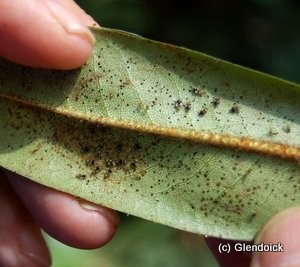 A serious problem in some areas. There are two different species of these sap-sucking insects, one which attacks rhododendrons and the other azaleas. Lace bug damage on leaves causes a greyish, or whitish leaf upper surface with a discolouring on the lower surface. The effect is most severe on plants grown in full sun and in shade it may not be a problem, where there are more lacebug predators to keep them under control. This problem is becoming serious in parts of Germany and probably in adjacent countries. The photo below shows the lacebug on the leaf underside. The upper surface tends to show yellow mottling.
A serious problem in some areas. There are two different species of these sap-sucking insects, one which attacks rhododendrons and the other azaleas. Lace bug damage on leaves causes a greyish, or whitish leaf upper surface with a discolouring on the lower surface. The effect is most severe on plants grown in full sun and in shade it may not be a problem, where there are more lacebug predators to keep them under control. This problem is becoming serious in parts of Germany and probably in adjacent countries. The photo below shows the lacebug on the leaf underside. The upper surface tends to show yellow mottling.
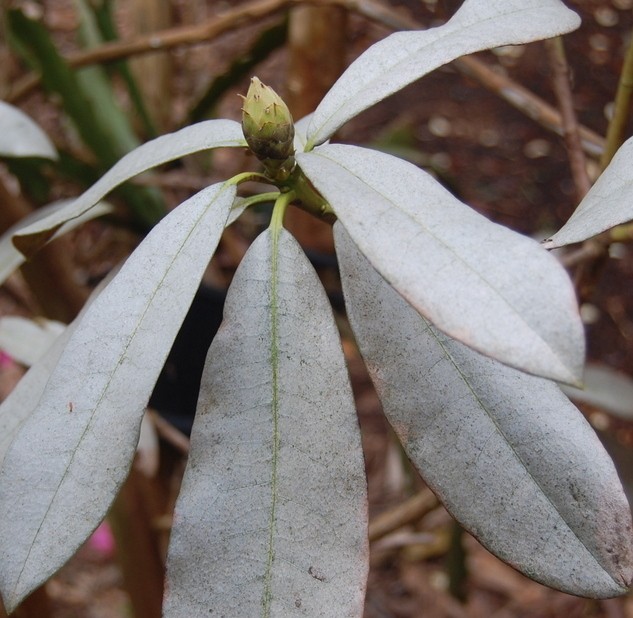 Thrips are sap sucking insects which leave silver mottling on the leaves. Google for locally available insecticides. We dont have this in Scotland. New Zealand, particularly North Island, has this badly.
Thrips are sap sucking insects which leave silver mottling on the leaves. Google for locally available insecticides. We dont have this in Scotland. New Zealand, particularly North Island, has this badly.
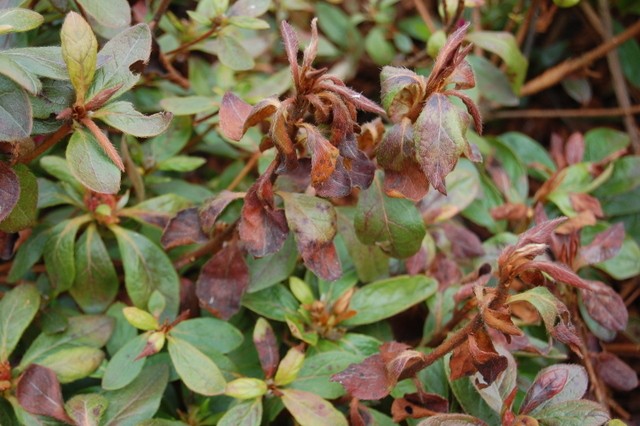
When the new growth buds begin to elongate before unfurling, the tips of the new leaves can be puckered by frosts causing them to distort when they unfurl.
This is mainly cosmetic but if it keeps happening you may need to move a plant to a more sheltered site or cover it up in frosty weather.
For insects use a contact or systemic insecticide. They tend to strike in dry weather and you'll find them on our under the leaves.
This is a general sign of unhappiness and can have many causes:
1. Rhododendron drainage is poor: solution: lift plant and improve soil structure or move to better drained spot. You need to do this before the plant starts to suffer as root problems caused by poor drainage can be fatal.
2. Rhododendron is planted too deep? The rootball should be at or just below the soil surface. If you cant feel the rootball then it is probably planted too deep. Lift the plant. If it has been in for a long time you may see new roots forming near the soil surface. Replant at the correct level. Do not let piles of mulch bury the plant. 10cm of mulch is more than enough. Do not use membrane and bark as rhododendrons dont like this.
3. Rhododendron is starved. Apply fertiliser April-May to Late June.
4. Rhododendron is suffering from lack of water: often due to competition from tree roots. Feed and water the plant and it will probably pick up. Think about thinning the shade or moving the plant if it is suffering.
5. Soil is too alkaline (unlikely in Scotland) pH 6 and higher. Soil acidity is measured by the pH scale. 7 in neutral. Chalky soils tend to be pH 7-9. Rhododendrons need a pH of 4-6. If you have alkaline soil, you will need to build raised beds and plant in peaty soil. Avoid watering with tap water if it is chalky. Use rainwater collected from rooves instead. You can have your soil tested but it is better to ask around as gardeners generally know if the local soil is alkaline or acidic. In Scotland virtually all soil is naturally acidic. Farmers do lime soil for crops but this washes out over 3 years or so. You can lower/acidfy the soil pH before planting by applying sulphur as alumineum or iron sulphate.
6. Mineral Deficiency Rhododendrons need specific minerals. Most of these are found naturally in soils. But in alkaline soil, rhododendrons take up too much calcium and not enough iron. Adding iron chelates or sequestrine can help but most of this time this is an expensive waste of time. The chorosis is far more likely caused by one of the reasons listed above: poor drainage, stravation, drought or poor planting.
7. Soil Too Acid Some rhododendrons dislike very acidic soil. Particularly those in Section Pognanthum. We use dolomitic limestone on these to bring the pH to around 6 which they prefer. They grow on limestone in China.
Is quite common after hot summers in many regions. Mild sunburn turns leaves bright yellow while a more severe attack will burn the leaves to a crisp. Move sunburned varieties into a more shady place if the problem persists. In Scotland sunburn is rare!
Lichens is common on older azaleas
Often form on old, straggly specimens, particularly when they have few leaves and are lacking in vigour.
Evergreen and deciduous azaleas seem particularly prone. You can scrub the lichen off, but often, it is a sign of poor soil conditions, lack of fertiliser or old age, and it can best be dealt with by rejuvenating the plants by pruning and fertilising them or by throwing them out and starting again.
Lichen tends to grow on weak plants rather than causing the weakness.
Pest and Disease information adapted from Kenneth Cox's book Rhododendrons and Azaleas a Colour Guide
1. Frost Damage If buds are formed and then turn brown, cause is usually frost. To avoid frosted buds, protect opening buds with fleece or plant later flowering varieties such as deciduous azaleas.
2. Flower buds do not form (flower buds are fatter than growth buds which are usually more pointed. Some varieties, especially species, take many years to flower. You may need to wait till plants are 10 years old for large leaved species for example.
3. If planted in too much shade, will not flower well: best to move to sunnier spot.
4. Fertiliser applied after late June encourages leaves, not flowers. Stop feeding in June.
5. Bud Blast fungus
Bud blast fungus: look for black bristles on the buds. It affects R. caucasicum hybrids such as 'Cunningham's White' in UK. Can be severe in Germany and other countries. Not much can be done about this. If it is very bad, consider destroying the worst affected plants.
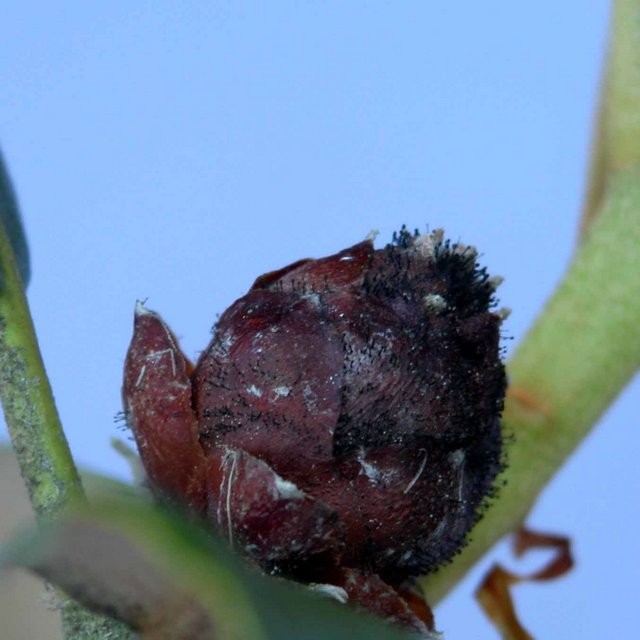
The larger the leaf the more shelter from wind is required.
Large leaved species such as R. hodgsonii and R. kesangiae have the least wind resistant leaves.
Solutions